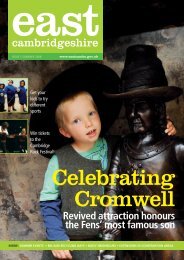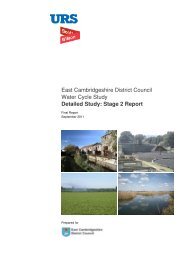6. Soham Conservation Area - East Cambridgeshire District Council
6. Soham Conservation Area - East Cambridgeshire District Council
6. Soham Conservation Area - East Cambridgeshire District Council
Create successful ePaper yourself
Turn your PDF publications into a flip-book with our unique Google optimized e-Paper software.
Age 19 th -20 th century<br />
Wall Materials Gault brick and render<br />
Roof Materials Slate<br />
Windows/Doors Mostly PVCu, some sliding sash windows. Mostly<br />
modern timber doors. Early timber panelled door to<br />
Baptist Church<br />
Scale 2-3 storeys<br />
Features Flat hood door surround and Classical detailing to Baptist<br />
Church<br />
9.16 Sand Street<br />
9.1<strong>6.</strong>1 Sand Street is essentially a southern extension of High Street that ends<br />
at Brook Dam. Several professional men lived in Sand Street during<br />
the mid 19 th century and as a result a number of architecturally<br />
ambitious brick houses from that period line the road. Few buildings<br />
stand directly on the back of the footpath and the more generous plot<br />
sizes means that there are large gaps in the building line. The entirely<br />
residential nature of the street indicated the end of the village centre,<br />
and the start of the southern ‘suburbs’.<br />
Age Late 18 th -19 th century<br />
Wall Materials Gault brick, stone or red brick detailing<br />
Roof Materials Slate; No.1 has clay fish-scale tiles<br />
Windows/Doors Sliding sashes, some PVCu replacements. Modern and<br />
early timber panelled doors<br />
Scale 1.5-2 storey<br />
Features Decorative bargeboards and eaves, red brick detailing.<br />
Classical detailing and chimneystacks.<br />
9.17 Clay Street (north side)<br />
9.17.1 Clay Street runs west from Red Lion Square along the south side of the<br />
Recreation Ground and towards the Mills on the western edge of the<br />
village. It is an old street (formerly known as Bull Lane), but has seen<br />
much infilling during the 20 th century, particularly on its northern side<br />
along the edge of the Recreation Ground. It was the location of many<br />
of the village’s smithies and two of its schools. Today, although it is<br />
predominantly residential, it is almost a secondary street to the main<br />
30






